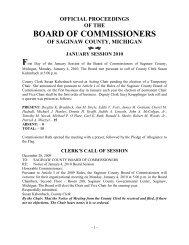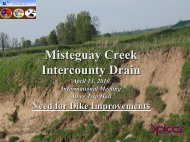The Metropolitan Transportation Planning ... - Saginaw County
The Metropolitan Transportation Planning ... - Saginaw County
The Metropolitan Transportation Planning ... - Saginaw County
Create successful ePaper yourself
Turn your PDF publications into a flip-book with our unique Google optimized e-Paper software.
<strong>The</strong> <strong>Metropolitan</strong> <strong>Transportation</strong> <strong>Planning</strong> Process: Key Issues<br />
from FHWA and FTA for the upcoming three years, and includes each MPO's TIP<br />
and all of the projects included in the first three years of that TIP.<br />
<strong>The</strong> STIP must be fiscally constrained, which means that the costs of the projects in<br />
the STIP must not exceed projected reasonably available revenue while ensuring<br />
continued funding for the operation and maintenance of the existing<br />
transportation system.<br />
Amendments to the STIP are common, given the frequency of changes in<br />
engineering modifications, environmental issues, contracting issues, project<br />
readiness, and other factors that require project schedules and budgets to be<br />
adjusted from time to time. If an MPO wants to amend a project in the STIP, it first<br />
must amend its TIP.<br />
What is the process by which a TIP gets programmed for funding?<br />
●<br />
●<br />
●<br />
●<br />
<strong>The</strong> TIP must be consistent with the transportation plan.<br />
In the TIP, the MPO indicates which projects will be worked on in each year.<br />
<strong>The</strong> MPO must identify which combination of funding sources (federal, state,<br />
local) will be used for each project and must show that enough funds will be<br />
available for all of the projects.<br />
Projects included in the first two years of the TIP must have funds (i.e., bonds)<br />
available or committed. Some projects are multi-year in nature, which will be<br />
indicated in the TIP.<br />
<strong>The</strong> TIP (after being approved by the MPO and the governor) is then submitted to<br />
the State DOT for inclusion in the STIP, which is then submitted to FHWA/ FTA. In air<br />
quality nonattainment and maintenance areas, the TIP must also meet<br />
transportation conformity requirements.<br />
How do MPOs know how much money is going to be available?<br />
TEA-21 requires that revenue forecasts be developed cooperatively by the MPO,<br />
the state DOT, and the public transit agency in order to help MPOs know how<br />
much funding is likely to be available for transportation projects in their area. This<br />
provision is intended to improve financial planning and enable a longer-term view<br />
of financial needs.<br />
What are the sources of transportation funds?<br />
<strong>Transportation</strong> funds come from a number of sources, including income tax, sales<br />
tax, tolls, bonds, and state, local, and federal excise taxes on various fuels, state<br />
infrastructure banks, and credit assistance sources. <strong>The</strong> source of transportation<br />
funds to construct a particular project can vary greatly from one area to another,<br />
because each area can decide which mix of funds is best suited to local needs.<br />
When federal funds are authorized by Congress for the U.S. Department of<br />
<strong>Transportation</strong>, they are allocated into various programs before DOT redirects them<br />
to the states. Some primary examples of these programs include the Interstate<br />
System/Interstate Maintenance Program, the Highway Bridge Replacement and<br />
Rehabilitation program, the Surface <strong>Transportation</strong> Program (STP) (which includes<br />
enhancements funding and safety funding), the Federal Lands Highway Program,<br />
and the Congestion Mitigation and Air Quality Improvement Program.<br />
Each of these programs has specific eligibility requirements, although there is quite<br />
a bit of flexibility in TEA-21 that allows the shifting of funds among some of the<br />
programs. For example, STP funding can be used for transit buses, and interstate<br />
program funds can be shifted to other programs so long as interstate highway


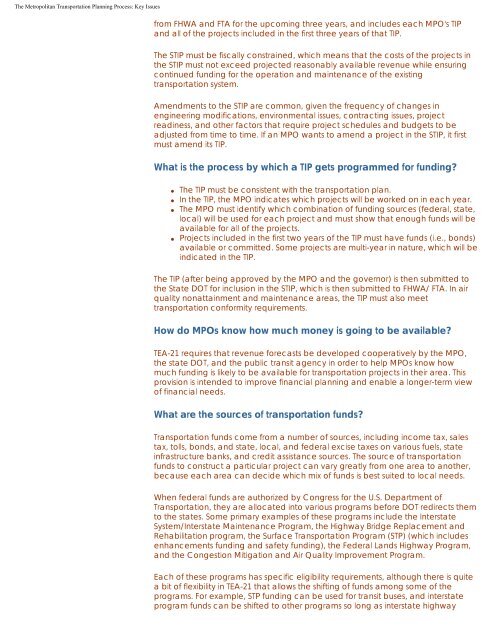
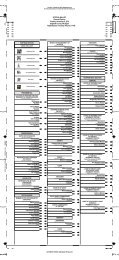
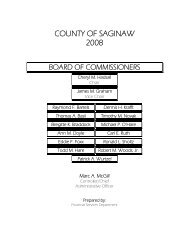
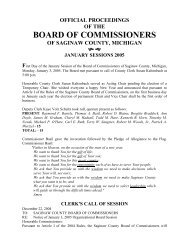
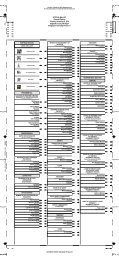

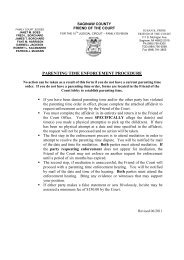
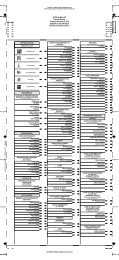


![[ Of Commissioners] - Saginaw County](https://img.yumpu.com/25951211/1/190x245/-of-commissioners-saginaw-county.jpg?quality=85)


